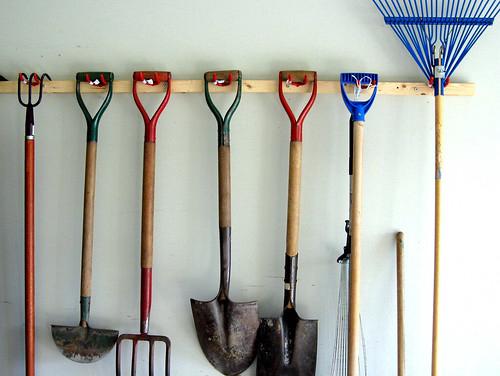Essential Gardening Tools: Ultimate Guide
Selecting the best gardening tools begins with a close look at what your garden demands. Consider the type of soil you have – a heavier-duty shovel for clay soil, and a lighter, easier-to-manage shovel for sandier types.
Think about the plants in your garden. Delicate tasks like snipping blossoms require a pair of reliable pruning shears with sharp, precise blades, while managing vegetable beds might need a solid, comfortable-to-hold garden trowel for planting and transplanting.
Gloves are essential for protecting your hands from blisters, thorns, and cuts. Leather gloves provide a heavy-duty shield for tackling prickly plants, while breathable cotton gloves suffice for light daily maintenance.
The condition of your garden is also significant. A well-maintained lawn or garden, starting or maintaining compost, requires a pitchfork or a compost turner to aerate and mix the materials efficiently.
For smaller spaces or potted plants and raised beds, hand rakes or cultivators are useful for aerating the soil around your plants, promoting healthy growth without disturbing their roots too much.
Finally, consider ergonomics when choosing tools. Rakes with padded handles ease the scrape across your lawn, and trowels with comfortable grips prevent hand fatigue as you plant and weed. Bearing ergonomics in mind is a necessity for long afternoons spent tending to your garden.
By integrating these considerations – soil type, plant varieties, task requirements, and physical comfort – you can curate a set of tools that lighten the workload and increase the joy and productivity of gardening. These choices empower both novice gardeners and seasoned green thumbs to approach their horticultural projects with confidence.
Maintaining and Storing Your Gardening Tools
The condition and longevity of your gardening tools directly correlate to how well they’re maintained and stored after each use. Here’s how to ensure your trusty garden helpers stay in top-notch condition year-round:
Cleaning: After a day’s work, knock off loose soil from your tools. For stubborn dirt, use a stiff brush and soapy water. A putty knife is handy for scraping off dried mud. Rinse well and dry before storing.
Sharpening Blades: Sharp tools make gardening tasks easier and reduce damage to plants during pruning. Use a fine metal file to sharpen pruners, loppers, and shears, following the angle of the existing edge. Apply a light coat of oil post-sharpening to prevent rust. For secateurs, dismantling them first may make sharpening and cleaning easier.
Caring for Wooden Handles: Regular inspection can catch any issues early. Sand down rough spots to prevent splinters. To preserve the wood, rub handles with linseed oil occasionally to protect against moisture and drying out.
Organizing and Storing Tools: Proper storage prolongs tool life and keeps your workspace orderly and safe. Hang tools vertically on hooks or pegs, keeping blades and points away from walkways. For smaller tools, use a toolbox, bucket, or garden tote. Allocate a specific place for each tool to save time and prevent last-minute scrambles.
Store tools in dry conditions, such as a shed or garage. For added rust prevention, place silica gel packs in the storage area to absorb excess moisture.
Investing time in maintaining and organizing your gardening tools is akin to investing in the beauty and bounty of your garden. By adhering to these routines, your tools will be primed and ready, making each gardening task a step easier and more enjoyable.

Innovative Gardening Tool Uses
Navigating gardening requires not just a green thumb but also the savvy use of the tools at your disposal. Expanding the versatility of your toolkit by uncovering innovative ways to employ common gardening tools can streamline your efforts, making you more efficient and your garden more vibrant. Let’s dive into some unconventional yet highly effective uses for your trusty gardening companions.
The hori hori knife does far more than slicing through tough soil. Its serrated edge makes it perfect for precision weeding between delicate plantings. It can also be used for planting bulbs and seedlings, with its depth markings aiding in gauging the perfect planting depth. When spring arrives and perennials demand division, this knife’s sturdy, sharp blade effortlessly slices through roots, creating healthy divisions ready for relocation.
The garden fork, often used merely for turning soil, also excels in several other roles. It can loosen soil around delicate root vegetables like carrots and potatoes for damage-free harvesting. The garden fork also aids in soil aeration by gently piercing the earth and slightly lifting, introducing air into compact soil to promote healthier root growth and water absorption.
Harvesting tools like scissors or pruning shears allow for clean cuts that keep your plants healthy and productive. These cuts allow for quick healing and reduce the risk of disease compared to tearing off produce.
A sturdy hand trowel, with its pointed tip, can reshape soil in planters or create furrows for seeding with precision and control.
The handles of most long tools, made sturdy and straight, can lay down lines in the soil for planting or help push stakes firmly into the ground without additional equipment. A rake can be repurposed to gather plant debris post-harvest, keeping your gardening area tidy and disease-free.
By embracing these alternate uses for standard gardening tools, you enhance your gardening efficiency and save on space and cost by minimizing the need for a vast arsenal of equipment. With a little creativity, any tool in your shed can become multifunctional, serving your garden’s needs across the seasons. The artistry of gardening lies not just in nurturing plants but in wielding our tools with imaginative flair, turning everyday tasks into a symphony of efficiency and innovation.

In conclusion, selecting the right gardening tools is about choosing tools that match your soil type, cater to your plant varieties, meet your task requirements, and ensure physical comfort. By doing so, you create an environment where both you and your garden can thrive together in harmony.










